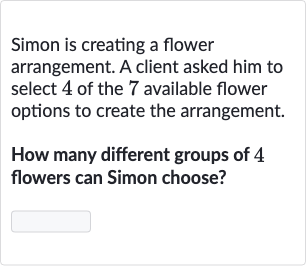Full solution
Q. Simon is creating a flower arrangement. A client asked him to select of the available flower options to create the arrangement.How many different groups of flowers can Simon choose?
- Identify problem type: Identify the type of problem. Simon is choosing flowers out of without regard to order, which is a combination problem.
- Use combination formula: Use the combination formula to calculate the number of different groups. The combination formula is , where is the total number of items to choose from, is the number of items to choose, and denotes factorial.
- Plug values into formula: Plug the values into the combination formula. Here, (total flower options) and (flowers to choose).
- Calculate factorials and simplify: Calculate the factorials and simplify the expression.
- Cancel out common terms: Cancel out the common terms in the numerator and the denominator.
- Perform calculation: Perform the calculation.
More problems from Counting principle
QuestionGet tutor help
QuestionGet tutor help
QuestionGet tutor help
QuestionGet tutor help
QuestionGet tutor help
QuestionGet tutor help
QuestionGet tutor help
QuestionGet tutor help
QuestionGet tutor help

